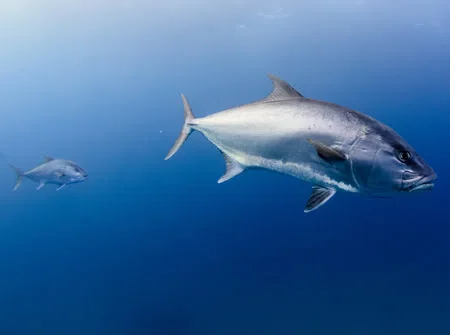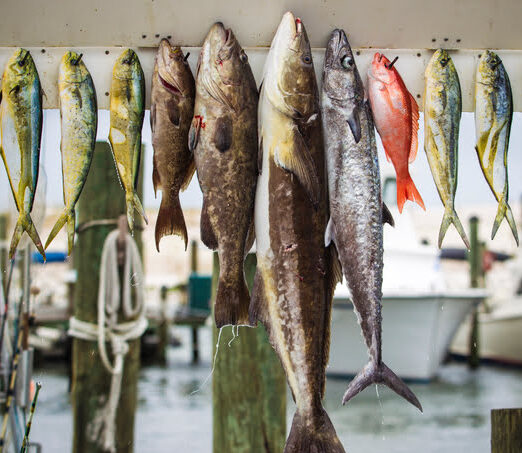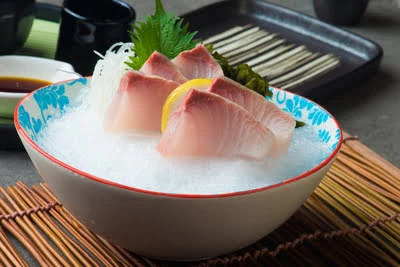Amberjack is a very common game fish, known for giving a fight that’s much bigger than their actual size would indicate (heck, their nickname is reef donkey!)
No doubt they are fun to catch…but is amberjack good to eat?
Let’s discuss!
Table of Contents
- Are Amberjack Good To Eat?
- What Do Amberjack Taste Like?
- Is Lesser Amberjack Good To Eat?
- Are Amberjack Safe To Eat?
- Is Amberjack Good For You?
- How To Prepare Amberjack
- How To Cook Amberjack
Are Amberjack Good To Eat?
Amberjack are known for their powerful fighting ability, but most anglers agree they are mediocre when it comes to edibility. Smaller individuals can be good when cooked fresh and are often prepared grilled or smoked.

Does that mean Amberjack is a total waste? Heck no!
Some people really like them, but more popular reef species like grouper and snapper usually get priority in the cooler.
What Do Amberjack Taste Like?
If prepared properly, amberjack has a mild flavor that’s been described as both sweet and salty; larger specimens can have a strong fishy taste. Amberjack fillets are white with a tint of pink and a dark red bloodline.
Flavor-wise, amberjack is very similar to the consistency of swordfish, with higher oil content. It has a somewhat stronger flavor than a grouper or a snapper and is best prepared fresh, not frozen.
Many anglers who want to cook amberjack soak the fillets in buttermilk, and cook with seasoning blends on high heat.
Is Lesser Amberjack Good To Eat?
The greater amberjack is often confused with the Jack Crevalle, but did you know there is also another species called the Lesser Amberjack?
The lesser amberjack is edible, but due to its smaller size it’s not usually kept by anglers. The meat has been described as bland and somewhat flavorless.

Do You Love Seafood?
Are Amberjack Safe To Eat?
Amberjack are safe to eat if you follow the proper precautions. There’s nothing inherently toxic about amberjack.
Worms
The issue most people associate with amberjack is worms. especially BIG amberjack (over 20 pounds).
In warm water, amberjack are commonly infested with a kind of saltwater worm.
The worm issue probably has more to do with any negative views of amberjack for eating than anything, since a fillet wriggling with white worms isn’t very appetizing to look at!
Once you’ve carved out your fillets, the worms are very easy to see, and you can just cut them out. If you do miss any, either freezing or cooking will kill them, and make the meat safe to eat.
In heavily infested fish, the infestation is visible when the fish is still alive as a bruised appearance on the skin.
The worms are fairly easily dealt with. They accumulate in the fish over time. The bigger an amberjack is, the more likely it is to have worms, and the bigger the population of tapeworms it will have.
Smaller amberjacks have fewer and may not have any!
Worms tend to cluster near the amberjack’s tail. If you just take off the last few inches of meat, you’ll get rid of almost all the worms.
Environmental Toxins
An issue with eating any predator fish is that not only do they absorb toxins from their environment, but they also absorb any toxins that their prey has absorbed from the environment.
The farther up the food chain an animal is and the older it is, the higher concentrations of toxins it may have.

Amberjack are fairly far up the food chain. One concern this creates is an accumulation of heavy metals like mercury.
Another common toxin of concern in certain areas is ciguatera. Ciguatera is created by microscopic algae.
Tiny animals eat the algae, small fish eat them, medium fish eat the small fish, and big amberjack eat the medium fish, taking in all that accumulated ciguatera.
Fortunately, both ciguatera and heavy metals are not a problem as long as you limit yourself to the smaller amberjacks.
A rule of thumb for amberjack eating is to keep ones that are just a little bit over the minimum legal size. If you do that, worms or toxins shouldn’t be a problem.
Is Amberjack Good For You?
An amberjack of the proper size is a very healthy fish.
A 4-ounce serving has 120 calories, 2 grams of fat, and 24 grams of protein. It also has zero carbohydrates.
This makes it an excellent source of high-quality protein and omega-3 fatty acids and is perfect for anyone on a low-carb diet.
How To Prepare Amberjack
There are two main objectives when cleaning amberjack: to remove any worms and to remove the bloodline, which has an unpleasant flavor.
To fillet the fish, start a cut right behind the pectoral fin and go up diagonally to the back of the head.
From here, cut straight back to the tail. Take this fillet and, at the back end, start to remove the skin with the knife.
Try to leave a millimeter or so of meat attached to the entire skin. If you do this, most of the bloodline will come off with the skin.
Remove any of the dark red bloodline that’s left behind, along with the last few inches of tail meat. Check the meat visually for any worms and cut them out.
You can now slice up the fillet to your desired size and cut out any bones in the process.
Can You Eat Amberjack Raw?
Amberjack can be eaten raw, and this is common in places like Japan. Slice the meat into thin 1/8″ slices, dip in soy sauce, and enjoy!
How To Cook Amberjack
Once you have your fillets, you can cook amberjack any way you want to. Its mild flavor makes it a very versatile ingredient and there is no need to do any milk or brine soaks or any of the other things that are done to moderate overly fishy flavors.
Amberjack is great when it’s breaded and fried, but it’s also great grilled with a light marinade like Italian dressing. It’s good for stews, soups, salads, or any other recipe.
It’s also very popular smoked and made into a fish dip (especially the larger individuals that may have a strong flavor).
You May Also Like: Jack Crevalle vs Yellow Jack…Differences Explained!

Growing up in Florida, I’ve been surrounded by saltwater my entire life…and I love sharing my passion with others.
To learn more about why I started Saltwater Mecca, visit the ABOUT page.
Thank you for reading this article. Browse around & have some fun!